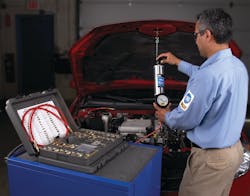Editor's note: This article was originally published Feb. 11, 2013. Some of the information may no longer be relevant, so please use it at your discretion.
Customer concern: Check engine light with code P2096.
Vehicle application:Mini 2005 Cooper 1.6
Average reported mileage:77,142 miles
Tests/procedures:
- Check long-term fuel trim values. Expect a value of five percent positive.
- Test operation of front and rear O2 sensors - the front should switch high and low in the range of 0-1V, and the rear should maintain a relatively steady 0.5V-0.7V at idle.
- If the front sensors switch normally, and the rears stay low, generally
- If the above tests come out okay, try cleaning injectors.
Tools used:
- Scan tool
- Injector cleaner
- Fuel injection tester
- Smoke machine
- Exhaust Gas Analyzer
Tech tips:
Code P2096 indicates that the rear O2 sensor registers a long-term lean condition. There is a technical service bulletin, #M12 01 06, that addresses this problem. Small leaks at exhaust system welds and flange gaskets as well as at bungs for O2 sensors are relatively common, and can be found by pressurizing the exhaust system and using soap solution to look for leaks, indicated by bubbles.
A customer brings in a 2005 Mini Cooper complaining the car is not driving well and has a “check engine” light. After scanning for DTCs, you see you have a P2096, indicating that the rear oxygen sensor is experiencing a long-term lean condition. Thankfully, there is a technical service bulletin (TSB), #M12 01 06, that addresses this problem.
The TSB refers to exhaust leaks at weld spots, gaskets, and at the bungs for the oxygen sensors that are relatively common. BMW recommends putting a restriction into the tailpipe and spraying soapy water on leak points while letting the car run. There is also an Identifix quick hit on the problem, indicating if the sensors are not stuck lean that clogged fuel injectors have been known to throw the P2096 as well.
Several tools can help find the problem the easy way. First, forget the soapy water! Use a smoke machine. Other tools will also help cut down on diagnostic time, including an emissions analyzer, bottle of propane, smoke machine and a scan tool with strong European-enhanced capabilities, just to name a few.
Step 1: Is it running lean?
Since we have a rear oxygen sensor reporting lean, and both a TSB and an Identifix quick hit indicating different causes that might lean out the senor, our first step is to confirm what is going on. Do we have a vehicle that is running lean (exhaust leak at the front oxygen sensor, vacuum leak on MAF vehicles, front oxygen sensor “stuck lean,” clogged injectors, weak fuel pump, etc.) or do we just have a lean rear sensor (exhaust leak before the rear sensor, rear sensor “stuck lean,” or mixture adaptation not done with a scan tool)?
With some scan tools, we can connect to repair databases such as Identifix. We need the test plan from Identifix or any other troubleshooter test tips if we do not know how to test to see whether the vehicle is running lean. What any of these databases can teach us is how to interpret long-term fuel trim (LTFT) values. This value is almost entirely dependent upon the front oxygen sensor, so if the vehicle is running lean, expect the LTFT to be above +7.
If the rear oxygen sensor is defective and merely shifted lean (or is being tricked by an exhaust leak), LTFT may be in a normal range (+ or -7), indicating the vehicle actually isn’t running lean, but the rear sensor thinks it is.
Another strategy, if analyzing fuel trim issues is difficult, is to simply place an emissions analyzer in the tail pipe and make sure your lambda is close to 1 (give or take +/- 0.03). If there is perfect lambda or good LTFT, but a code appears for a lean rear sensor, be assured the vehicle isn’t actually running lean but the rear sensor alone is stuck lean.
Step 2: Test the oxygen sensors
On the scan tool, if the oxygen sensor in the front is switching between 150 and 850-mV, but the rear one is stuck low (around 0 to 300 mV consistently), then we know that only the rear oxygen sensor is being forced lean because it is defective or there is an exhaust leak. If the front sensor stays consistently below 450-mV, then the rear sensor will likely be low, too, because something is forcing the whole system lean (front oxygen sensor stuck lean, vacuum leak on MAF vehicles, etc.)
Since these sensors go bad all the time, what’s a quick way to test them? Use a scan tool and a bottle of propane. Simply add some propane through the ABS brake booster hose to see if the front oxygen sensor mV goes up. If the front oxygen sensor does not budge but the rear one does, the front one needs to be replaced. Conversely, if the front sensor nudges but the rear one does not, the rear needs replacing.
If both the sensors change readings thanks to propane, it’s time to use a smoke machine. There might be an exhaust leak around one of the sensors throwing the reading off, or a vacuum leak leaning out the fuel mixture. Smoking a vehicle is easy. To smoke the exhaust, simply block one of the tailpipes and put the smoke machine in the other. For an exhaust leak to be bad enough to throw off an oxygen sensor, the leak will be large enough where the smoke will be clearly visible.
If there is no smoke machine available, use an emissions analyzer to look for elevated HC, which would be typical of an exhaust leak around critical leak points as per the TSB.
Without any exhaust leak or oxygen sensor problem, there is something else making the vehicle run lean. Since it is easier to check the intake system as opposed to the fuel system, it makes sense to smoke the intake through the ABS brake booster hose. However, the Mini is a speed-density system that would run rich with an intake leak, not lean, so the proper approach is to diagnose the fuel system.
Step 3: Test the fuel system
On many vehicles, the easiest thing to check first is the fuel pressure simply by hooking up the fuel pressure gauge to a testing port, often on the fuel rail. On a good Mini with a super charger, KOEO and KOER fuel pressure should be about 3.5 BAR/53 PSI. A regular mini should be about 3.0 BAR/43/ PSI. If fuel pressure does not meet this spec, Identifix suggests cleaning the fuel injectors. However, it is wise to rule out the fuel pump first on most vehicles.
The fuel pump on Minis is extremely hard to connect due to lack of clearance with a fuel volume tool, but it is doable with modifications. For this reason, it makes sense to check fuel volume only after checking the fuel injectors. Keep in mind that this vehicle has an intercooler, so it should flow at least 0.6 GPM.
The fuel pump is ruled out by process of elimination, moving on to the fuel injectors first. To test the fuel injectors, remove the intercooler and connect a fuel injector tester to each fuel injector with a fuel pressure gauge connected to the fuel rail. The directions on how to use different fuel injector testers might differ a little, but essentially all that needs to be done is to connect the tester’s power and ground to the battery terminals, fit the plug into the injector, and select the amperage for the injector. Then activate the tool, which duty cycles the injector.
There is an injector problem if the pressure at the fuel rail differs between different injectors. Remember to start the car after testing each injector to avoid “hydro locking” the engine.
An off-car fuel injector tester can do a more accurate job of testing fuel injectors. Simply plug in fuel injectors with the right fittings and perform a uniformity test. If there is a difference in a spray pattern between injectors where it looks uneven or the volume of what sprayed is different, the injector spraying deficiently has a problem. A difference of about seven percent in spray volume indicates an injector issue that would cause a drivability problem. Injectors otherwise will have slight deviations in spray volume, but that is nothing to be concerned about.
Step 4: Fix the problem
Tools used in this step are an OEM enhanced scan tool, an on-car fuel injector cleaner, slidehammer, andan ultrasonic fuel injector cleaner.
If we have a bad fuel injector, there is no fuel delivery issue causing the vehicle to run lean.
The best method to fix the problem is to clean all of the fuel injectors with an ultrasonic fuel injector cleaner so they have equal performance. The tool simply pulses the fuel injectors on and off while the pintles bathe in a vibrating bath of ultrasonic cleaning solution. Always use approved fluids to clean and test fuel injectors to prevent damage.
If the fuel injector is out of the car, change the screens on the top by sticking the pointy head of a slide hammer in, popping the screen out and sticking a new screen in.
Minus the luxury of fixing fuel injectors out of the car, use an on-car fuel injector cleaner tool. Connect the tool to the fuel rail and pull the relay out for the fuel pump. Add shop air to the tool, which then delivers the fuel injector cleaning solution. Then run the car using the solution as fuel. Some people dilute the solution with gasoline to make it last longer. Typically, fuel injectors cleaned this way will clear up over time if they are not better right away. Other times, a second cleaning is needed.
Last but not least, use the OEM-enhanced scan tool to perform a fuel mixture adaptation. Without a scan tool with dealer-level capabilities, this adaptation cannot be performed and the P2096 will eventually return.

